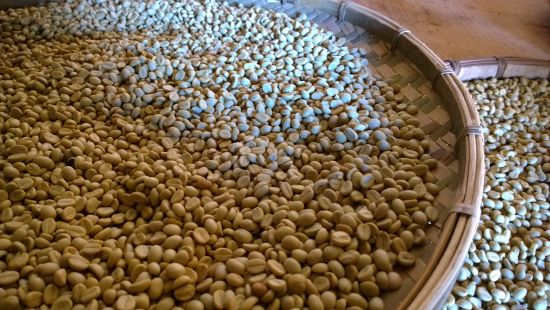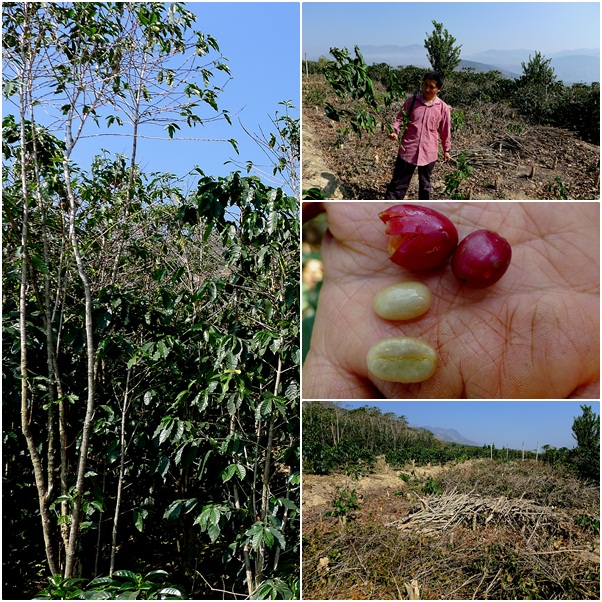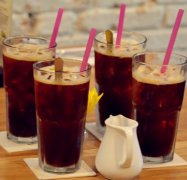Make your own fresh coffee beans, pick raw beans, roast raw beans.
Freshly picked coffee
1. Raw bean processing:
1. Picking
It is divided into mechanical picking and manual picking. Mechanical picking is suitable for coffee gardens with flat land and large areas of planting. Brazil is the most frequent user of mechanical picking coffee in the world. This method is characterized by low cost and high efficiency, but the coffee beans picked are uneven and of poor quality. For coffee beans with higher quality requirements, the method of manual picking is generally adopted, which ensures that the picked coffee fruit has uniform size, similar maturity, no other impurities, and is beneficial to the post-processing of coffee beans.
2. From fruit to coffee beans:
The processing methods from coffee fruit to coffee beans can be roughly classified as dry processing and wet processing.
Dry processing: the coffee fruit is dried and dehydrated by natural conditions such as sunlight and ventilation, and then the dried coffee fruit is put into the peeled pulp, peel and silver skin. This method is the most economical and traditional processing method, the coffee beans treated by this method can maintain the fragrance for a long time, but also have a certain environmental smell. At present, this method is widely used in many parts of Africa and Asian countries, but with the progress of science and technology, many places have begun to use dryers to dry coffee fruit.
Wet processing: also known as water washing processing, using soaking to screen the coffee fruit, and then the selected fruit through fermentation, extrusion and other methods to remove the peel, pulp and silver surface slippery pulp, processed coffee beans will retain the surface of the silver skin for storage, this state of coffee beans called "parchment coffee beans" (Parchment Coffee), until export before using the peeling machine to remove the dried silver skin. The biggest advantage of wet processing is that the appearance quality of coffee beans is good, and the original flavor is maintained well. The disadvantage is that the processing cost is high and a lot of water is needed. It is generally used for the processing of high quality coffee beans.
2. Baking
Coffee bean roasting is a process in which raw beans are converted into sugars and acids by means of specific equipment at high temperature. in this process, substances such as cellulose will be carbonized to varying degrees, water and carbon dioxide will be volatilized, and the protein will be converted into enzymes, which combine with the rest of the fat to form an oil film on the surface of the coffee, and the coffee bean itself will expand by baking. Pores are created inside. Roasted coffee beans can produce special aromas and different flavors before they can be used to brew coffee.
Coffee bean roasting is a complicated processing technology, which is quite professional. If you want to make delicious coffee beans, you need perfect equipment and high coffee roasting technology, so unless it is for personal pleasure, it is generally not suitable for family.
With the size of the baking firepower, the length of time, coffee beans will show different depth and taste changes. Different characteristics of coffee beans, different drinking methods determine the depth of roasting of coffee beans. Generally speaking, the roasting degree is light, the coffee bean color will be light brown, the sour taste is strong, and the baking degree is deep, the hue is dark, and the bitterness is enhanced. Traditionally, the roasting of coffee beans is divided into eight different degrees:
The lightest baking (Light)-slightly yellowish coffee color, not very strong aroma and flavor
Light roasting (Cinnamon)-cinnamon color, slightly better flavor, a kind of American coffee
Ordinary roasting (Medium)-maroon, mellow, moderately sour, a kind of American coffee
Medium baking (High)-A slightly thicker baking method than shallow baking, with bitter acid and good aroma and flavor.
Medium and deep roasting (City)-the word City- comes from New York City and is a standard roasting method suitable for Colombian and New York-style coffee
Strong roasting (Full City)-no sour but bitter, suitable for iced coffee
Strong roasting (French)-French, also known as European style, due to the strong degree of baking, coffee beans fat oozing surface, dark color, strong bitterness, with a unique flavor
The strongest roasting (Italian), also known as Italian style, has a strong roasting degree, and the coffee beans are carbonized black, scorched and without aroma, so they are suitable for brewing Italian steam coffee.
Third, storage:
1. Raw beans:
The raw coffee beans before stir-frying are only for the convenience of transshipment, without special packaging conditions, depending on the different production areas.
For economic and practical considerations, it is generally packed in 60 kg gunny bags and further processed after arriving at the destination. Of course, there will be some different packaging, such as Jamaica Blue Mountain is packed in 70kg wooden barrels.
2. Cooked beans:
Roasted coffee beans are easy to oxidize with oxygen in the air, making the aroma volatilized, the oil quality deteriorated, and the smell of decay. How to maintain the aroma of coffee and prevent the deterioration caused by external temperature, humidity and light is the main task of coffee bean storage.
In addition, because coffee beans produce a considerable amount of carbon dioxide gas after roasting, and carbon dioxide also reduces the aroma of coffee, the packaging of cooked coffee beans should not only avoid contact with the air, but also try to remove carbon dioxide from coffee beans. At present, the commonly used coffee bean packaging methods are as follows:
Flexible non-airtight packaging: this is the most economical one. It is usually used by local small baking plants because they can guarantee rapid supply and coffee beans can be consumed in time. Coffee beans in this way can only be preserved for a short time. Usually no more than a week.
Airtight packaging: suitable for bars, shelves or families, mainly in small bags and cans, coffee is vacuum and sealed after being packed. As carbon dioxide is produced after roasting, this method can only be carried out after the coffee has been degassed for a period of time. The storage period of coffee beans should be longer than that of coffee powder. Because the storage period does not need to be separated from the air, so the cost is low. The coffee under this packing should be used up within 10 weeks.
One-way valve packaging: a variety of sealed containers can be used. The roasted coffee is put into a special airtight container with an one-way valve, which can only remove the gas without inflow, ensuring the insulation of the coffee from the outside air and the timely discharge of carbon dioxide. There is no need for separate storage stage, but due to the outgassing process, there will be a certain loss of aroma. This method can avoid the formation of rotten smell, but can not prevent the loss of aroma.
Pressurized packaging: this is the most expensive way, but it can preserve coffee for up to two years. The size depends on the type of user, family or bar. After a few minutes of baking, the coffee can be packed in a vacuum. After adding some inert gas, the appropriate pressure is maintained in the package, and the coffee beans are preserved under pressure, leaving the aroma on the fat, thus improving the aroma of the beverage.

Important Notice :
前街咖啡 FrontStreet Coffee has moved to new addredd:
FrontStreet Coffee Address: 315,Donghua East Road,GuangZhou
Tel:020 38364473
- Prev

Yunnan Coffee Yunnan coffee varieties Tiebika and Bobang Yunnan coffee cultivation history
Yunnan coffee in China Yunnan coffee large-scale cultivation was in the mid-1950s, once planted on a scale of 4000 hectares. By the end of 1997, the province's coffee planting area had reached 7800 hectares. At present, the province's planting area accounts for 70% of the country's area, and its output accounts for 83% of the country's total. Whether it is from the planting area or coffee bean output, Yunnan coffee has established its dominant position in China. Jane
- Next

Pure Vietnamese iced coffee how to make Vietnamese iced coffee? Secret of making iced coffee in Vietnam
Vietnamese iced coffee is smooth and mellow, with milk fragrance overflowing. So in this hot summer, Vietnamese iced coffee has become an upstart in relieving heat. Drinking coffee is a daily habit of the Vietnamese. Vietnamese coffee is not brewed in a coffee pot, but through a special dripping coffee cup, drop by drop, enjoy the wonderful time. Required materials: medium-sized coffee powder (avoid leaving too much waste when dripping
Related
- Detailed explanation of Jadeite planting Land in Panamanian Jadeite Manor introduction to the grading system of Jadeite competitive bidding, Red bid, Green bid and Rose Summer
- Story of Coffee planting in Brenka region of Costa Rica Stonehenge Manor anaerobic heavy honey treatment of flavor mouth
- What's on the barrel of Blue Mountain Coffee beans?
- Can American coffee also pull flowers? How to use hot American style to pull out a good-looking pattern?
- Can you make a cold extract with coffee beans? What is the right proportion for cold-extracted coffee formula?
- Indonesian PWN Gold Mandrine Coffee Origin Features Flavor How to Chong? Mandolin coffee is American.
- A brief introduction to the flavor characteristics of Brazilian yellow bourbon coffee beans
- What is the effect of different water quality on the flavor of cold-extracted coffee? What kind of water is best for brewing coffee?
- Why do you think of Rose Summer whenever you mention Panamanian coffee?
- Introduction to the characteristics of authentic blue mountain coffee bean producing areas? What is the CIB Coffee Authority in Jamaica?

